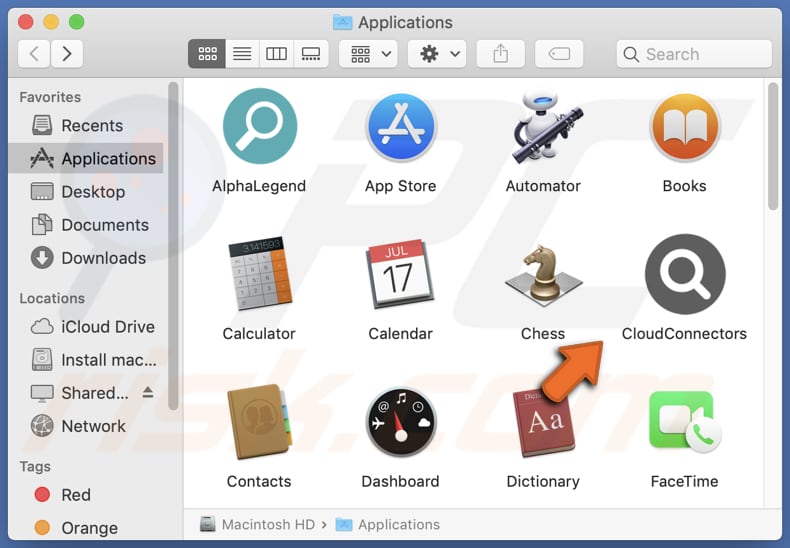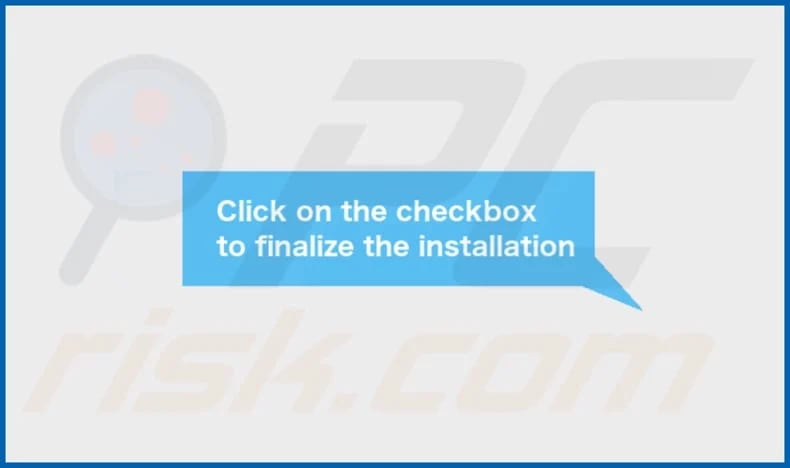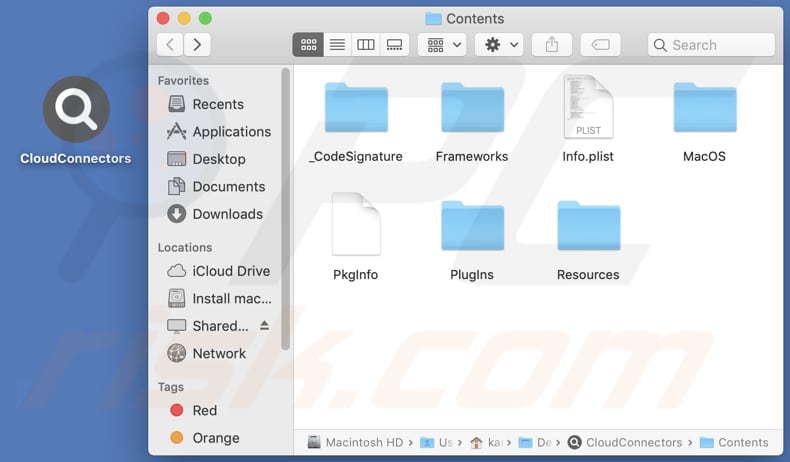How to remove CloudConnectors unwanted app from your computer
Mac VirusAlso Known As: Ads by CloudConnectors
Get free scan and check if your device is infected.
Remove it nowTo use full-featured product, you have to purchase a license for Combo Cleaner. Seven days free trial available. Combo Cleaner is owned and operated by RCS LT, the parent company of PCRisk.com.
What kind of application is CloudConnectors?
Upon reviewing CloudConnectors, our team concluded that its main purpose is to present intrusive advertisements to users, classifying it as adware. Notably, applications like CloudConnectors are often downloaded and installed without users' awareness. Thus, it is recommended not to trust such apps.

CloudConnectors adware in detail
CloudConnectors bombards its users with advertisements that may lead them to potentially harmful websites. Certain ads could direct users to deceptive pages, enticing them to call fake technical support numbers, download suspicious applications, and disclose sensitive information like credit card details, ID card information, passwords, etc.
Moreover, ad-supported software such as CloudConnectors can display advertisements with the capability to trigger unwanted downloads and installations without the user's consent. Hence, it is highly recommended not to place trust in CloudConnectors or any of its ads.
Another motivation to remove CloudConnectors from your operating system is that such applications may be designed to gather sensitive data, including passwords, credit card details, and other personal information that could be misused to commit identity theft, access and steal online accounts, cause financial harm, and other problems.
| Name | Ads by CloudConnectors |
| Threat Type | Adware, Mac malware, Mac virus |
| Detection Names | Avast (MacOS:Adload-CC [Adw]), Combo Cleaner (Adware.MAC.Generic.27804), ESET-NOD32 (A Variant Of OSX/Adware.Synataeb.F), Kaspersky (Not-a-virus:HEUR:AdWare.OSX.Adload.h), Full List (VirusTotal) |
| Additional Information | This application belongs to Adload malware family. |
| Symptoms | Your Mac becomes slower than normal, you see unwanted pop-up ads, you are redirected to dubious websites. |
| Distribution methods | Deceptive pop-up ads, free software installers (bundling), torrent file downloads. |
| Damage | Internet browser tracking (potential privacy issues), display of unwanted ads, redirects to dubious websites, loss of private information. |
| Malware Removal (Windows) |
To eliminate possible malware infections, scan your computer with legitimate antivirus software. Our security researchers recommend using Combo Cleaner. Download Combo CleanerTo use full-featured product, you have to purchase a license for Combo Cleaner. 7 days free trial available. Combo Cleaner is owned and operated by RCS LT, the parent company of PCRisk.com. |
More about adware
In addition to presenting unwanted ads, adware can also promote questionable search engines by hijacking web browsers. Browser-hijacking applications typically modify the default search engine, homepage, and (or) new tab page settings. Utilizing unreliable search engines can lead to potentially malicious sites and cause issues regarding online privacy.
Some examples of applications similar to CloudConnectors are CreativeApply, CorporateGlobe, and OuterSource.
How did CloudConnectors install on my computer?
Users can inadvertently install adware through various means, often without their knowledge. One common method is through software bundles, where adware is packaged with other programs. During installations, users may overlook the bundled adware and unintentionally install it on their computers (or add it to their browsers).
Additionally, clicking on deceptive advertisements or links can lead to adware installations, as well as downloading files from untrustworthy websites, shady stores, P2P networks, etc., or engaging with suspicious pop-ups that prompt users to install unwanted software.
How to avoid installation of unwanted applications?
Make sure to download software only from reputable sources, like official websites of software providers or verified app stores. Avoid using P2P networks, third-party downloaders, free file hosting sites, and similar platforms to download apps or files.
Always check the provided options (like "Custom" or "Advanced") and the terms and conditions during software installations, and decline offers to install additional programs or browser extensions. Avoid clicking on ads or links on dubious websites. If your computer is already infected with CloudConnectors, we recommend running a scan with Combo Cleaner Antivirus for Windows to automatically eliminate this adware.
A message that appears after the installation of CloudConnectors:

The installation folder of CloudConnectors app:

Instant automatic malware removal:
Manual threat removal might be a lengthy and complicated process that requires advanced IT skills. Combo Cleaner is a professional automatic malware removal tool that is recommended to get rid of malware. Download it by clicking the button below:
DOWNLOAD Combo CleanerBy downloading any software listed on this website you agree to our Privacy Policy and Terms of Use. To use full-featured product, you have to purchase a license for Combo Cleaner. 7 days free trial available. Combo Cleaner is owned and operated by RCS LT, the parent company of PCRisk.com.
Quick menu:
- What is CloudConnectors?
- STEP 1. Remove CloudConnectors related files and folders from OSX.
- STEP 2. Remove CloudConnectors ads from Safari.
- STEP 3. Remove CloudConnectors adware from Google Chrome.
- STEP 4. Remove CloudConnectors ads from Mozilla Firefox.
Video showing how to remove CloudConnectors adware using Combo Cleaner:
CloudConnectors adware removal:
Remove CloudConnectors-related potentially unwanted applications from your "Applications" folder:

Click the Finder icon. In the Finder window, select "Applications". In the applications folder, look for "MPlayerX", "NicePlayer", or other suspicious applications and drag them to the Trash. After removing the potentially unwanted application(s) that cause online ads, scan your Mac for any remaining unwanted components.
DOWNLOAD remover for malware infections
Combo Cleaner checks if your computer is infected with malware. To use full-featured product, you have to purchase a license for Combo Cleaner. 7 days free trial available. Combo Cleaner is owned and operated by RCS LT, the parent company of PCRisk.com.
Remove adware-related files and folders

Click the Finder icon, from the menu bar. Choose Go, and click Go to Folder...
 Check for adware generated files in the /Library/LaunchAgents/ folder:
Check for adware generated files in the /Library/LaunchAgents/ folder:

In the Go to Folder... bar, type: /Library/LaunchAgents/

In the "LaunchAgents" folder, look for any recently-added suspicious files and move them to the Trash. Examples of files generated by adware - "installmac.AppRemoval.plist", "myppes.download.plist", "mykotlerino.ltvbit.plist", "kuklorest.update.plist", etc. Adware commonly installs several files with the exact same string.
 Check for adware generated files in the ~/Library/Application Support/ folder:
Check for adware generated files in the ~/Library/Application Support/ folder:

In the Go to Folder... bar, type: ~/Library/Application Support/

In the "Application Support" folder, look for any recently-added suspicious folders. For example, "MplayerX" or "NicePlayer", and move these folders to the Trash.
 Check for adware generated files in the ~/Library/LaunchAgents/ folder:
Check for adware generated files in the ~/Library/LaunchAgents/ folder:

In the Go to Folder... bar, type: ~/Library/LaunchAgents/

In the "LaunchAgents" folder, look for any recently-added suspicious files and move them to the Trash. Examples of files generated by adware - "installmac.AppRemoval.plist", "myppes.download.plist", "mykotlerino.ltvbit.plist", "kuklorest.update.plist", etc. Adware commonly installs several files with the exact same string.
 Check for adware generated files in the /Library/LaunchDaemons/ folder:
Check for adware generated files in the /Library/LaunchDaemons/ folder:

In the "Go to Folder..." bar, type: /Library/LaunchDaemons/

In the "LaunchDaemons" folder, look for recently-added suspicious files. For example "com.aoudad.net-preferences.plist", "com.myppes.net-preferences.plist", "com.kuklorest.net-preferences.plist", "com.avickUpd.plist", etc., and move them to the Trash.
 Scan your Mac with Combo Cleaner:
Scan your Mac with Combo Cleaner:
If you have followed all the steps correctly, your Mac should be clean of infections. To ensure your system is not infected, run a scan with Combo Cleaner Antivirus. Download it HERE. After downloading the file, double click combocleaner.dmg installer. In the opened window, drag and drop the Combo Cleaner icon on top of the Applications icon. Now open your launchpad and click on the Combo Cleaner icon. Wait until Combo Cleaner updates its virus definition database and click the "Start Combo Scan" button.

Combo Cleaner will scan your Mac for malware infections. If the antivirus scan displays "no threats found" - this means that you can continue with the removal guide; otherwise, it's recommended to remove any found infections before continuing.

After removing files and folders generated by the adware, continue to remove rogue extensions from your Internet browsers.
Remove malicious extensions from Internet browsers
 Remove malicious Safari extensions:
Remove malicious Safari extensions:

Open the Safari browser, from the menu bar, select "Safari" and click "Preferences...".

In the preferences window, select "Extensions" and look for any recently-installed suspicious extensions. When located, click the "Uninstall" button next to it/them. Note that you can safely uninstall all extensions from your Safari browser - none are crucial for regular browser operation.
- If you continue to have problems with browser redirects and unwanted advertisements - Reset Safari.
 Remove malicious extensions from Google Chrome:
Remove malicious extensions from Google Chrome:

Click the Chrome menu icon ![]() (at the top right corner of Google Chrome), select "More Tools" and click "Extensions". Locate all recently-installed suspicious extensions, select these entries and click "Remove".
(at the top right corner of Google Chrome), select "More Tools" and click "Extensions". Locate all recently-installed suspicious extensions, select these entries and click "Remove".

- If you continue to have problems with browser redirects and unwanted advertisements - Reset Google Chrome.
 Remove malicious extensions from Mozilla Firefox:
Remove malicious extensions from Mozilla Firefox:

Click the Firefox menu ![]() (at the top right corner of the main window) and select "Add-ons and themes". Click "Extensions", in the opened window locate all recently-installed suspicious extensions, click on the three dots and then click "Remove".
(at the top right corner of the main window) and select "Add-ons and themes". Click "Extensions", in the opened window locate all recently-installed suspicious extensions, click on the three dots and then click "Remove".

- If you continue to have problems with browser redirects and unwanted advertisements - Reset Mozilla Firefox.
Frequently Asked Questions (FAQ)
What harm can adware cause?
Adware can cause harm by inundating users with intrusive and unwanted advertisements, leading to a disruptive and annoying web browsing experience. Additionally, it may compromise the system's performance and security, potentially slowing down the computer and exposing users to potential risks associated with malicious ads or links.
What does adware do?
Adware, short for advertising-supported software, delivers intrusive advertisements to users. Moreover, it can be designed to take control over web browsers and gather information.
How do adware developers generate revenue?
Adware developers primarily earn revenue by promoting a variety of products, websites, or services. Much of their income is generated through affiliate programs, where they receive commissions for driving traffic or sales to the promoted products or services.
Will Combo Cleaner remove CloudConnectors adware?
Manual removal might not always be effective, as some file leftovers could still be present in the system even after the software is deleted, potentially causing the adware to persist and continue running. Combo Cleaner will conduct a thorough scan of your computer and remove all adware-type apps from it.
Share:

Tomas Meskauskas
Expert security researcher, professional malware analyst
I am passionate about computer security and technology. I have an experience of over 10 years working in various companies related to computer technical issue solving and Internet security. I have been working as an author and editor for pcrisk.com since 2010. Follow me on Twitter and LinkedIn to stay informed about the latest online security threats.
PCrisk security portal is brought by a company RCS LT.
Joined forces of security researchers help educate computer users about the latest online security threats. More information about the company RCS LT.
Our malware removal guides are free. However, if you want to support us you can send us a donation.
DonatePCrisk security portal is brought by a company RCS LT.
Joined forces of security researchers help educate computer users about the latest online security threats. More information about the company RCS LT.
Our malware removal guides are free. However, if you want to support us you can send us a donation.
Donate
▼ Show Discussion